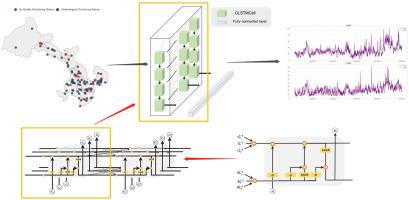Atmospheric Pollution Research ( IF 3.9 ) Pub Date : 2021-07-30 , DOI: 10.1016/j.apr.2021.101150 Xi Gao 1 , Weide Li 1

|
Accuracy prediction of air quality is of crucial importance for people to take precautions and improve environmental conditions. By introducing adjacency matrix in Long Short-Term Memory (LSTM) cell, we propose in this research a Graph-based Long Short-Term Memory (GLSTM) model to predict PM2.5 concentration in Gansu Province of Northwest China. We regard all air quality monitoring stations as a graph, and construct a parameterized adjacency matrix on the basis of the adjacency matrix of the graph. Through the combination of parameterized adjacency matrix and LSTM, we introduce spatiotemporal information to achieve PM2.5 prediction. The advantage of GLSTM is that it can realize synchronous operation of all stations, making it unnecessary to train different model for each monitoring station to obtain the overall PM2.5 variation of a certain area. The parameterized adjacency matrix also enhances the interpretability of the model. By visualizing the parameterized adjacency matrix obtained from the end-to-end PM2.5 prediction task in training, the importance of introducing spatial information, i.e. the distribution importance of surrounding stations to a specific station is clearly demonstrated. We compared our model with several newly reported methods, and found that it achieved the best results on PM2.5 prediction tasks at almost all stations, which proved the effectiveness of the GLSTM model.











































 京公网安备 11010802027423号
京公网安备 11010802027423号